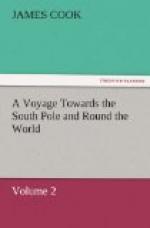I judged that the tide rises about four or five feet, and that it is high water on the full and change days about eleven o’clock.
The head of the bay, as well as two places on each side, was terminated by perpendicular ice-cliffs of considerable height. Pieces were continually breaking off, and floating out to sea; and a great fall happened while we were in the bay, which made a noise like cannon.
The inner parts of the country were not less savage and horrible. The wild rocks raised their lofty summits till they were lost in the clouds, and the valleys lay covered with everlasting snow. Not a tree was to be seen, nor a shrub even big enough to make a toothpick. The only vegetation we met with was a coarse strong-bladed grass growing in tufts, wild burnet, and a plant like moss, which sprung from the rocks.
Seals, or sea-bears, were pretty numerous. They were smaller than those at Staten Land: Perhaps the most of those we saw were females, for the shores swarmed with young cubs. We saw none of that sort which we call lions; but there were some of those which the writer of Lord Anson’s voyage describes under that name; at least they appeared to us to be of the same sort; and are, in my opinion, very improperly called lions, for I could not see any grounds for the comparison.
Here were several flocks of penguins, the largest I ever saw; some which we brought on board weighed from twenty-nine to thirty-eight pounds. It appears by Bougainville’s account of the animals of Falkland Islands, that this penguin is there; and I think it is very well described by him under the name of first class of penguins*. The oceanic birds were albatrosses, common gulls, and that sort which I call Port Egmont hens, terns, shags, divers, the new white bird, and a small bird like those of the Cape of Good Hope, called yellow birds; which, having shot two, we found most delicious food.
[* See Bougainville, English translation p.64.]




